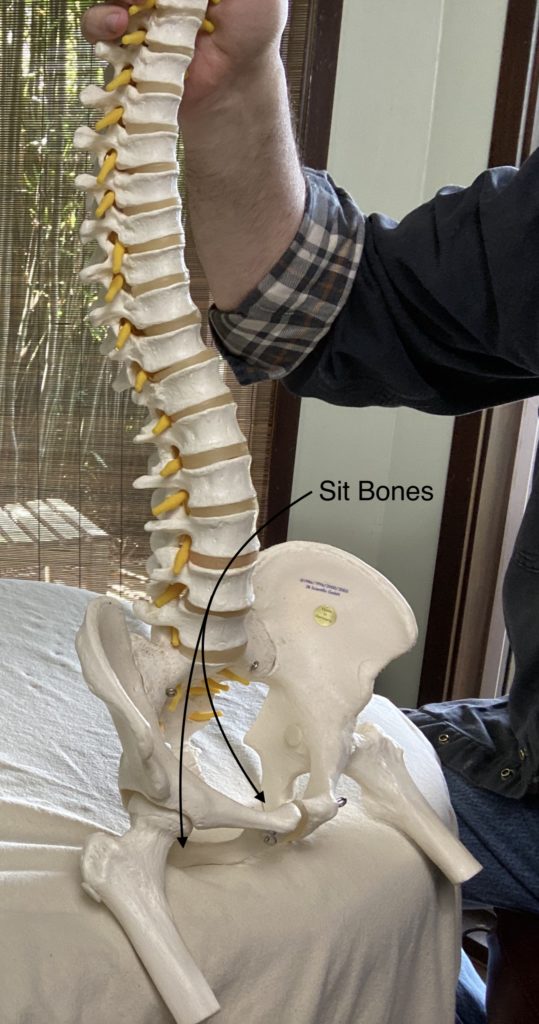Chairs are an icon of urbanization. Our information-age surroundings constrain the scope of how we move. Easily one-half of the world’s population still rests by squatting – an innate function we often lose access to by living within surroundings constrained by the ubiquitous prevalence of chairs, and work surfaces configured for chair sitting. While maximizing our movement scope is always beneficial, we can minimize the negative effects of chair sitting by ensuring our work areas are optimized and that we sit on our sit bones.
Sit(z) Bones:
Our physiology did not evolve to sit on chairs and while unnatural, the degenerative consequences can be minimized by fine-tuning our postural dynamics while sitting. This fine-tuning involves finding and then using our Sit Bones. These are two bony protruberances at the base of our pelvis. They are the compressional “end-stops” when we rest our torso on something. For many of us, these will be tender from underuse. However, it is important to cultivate their robustness as sitting on them facilitates optimal postural alignment.


SITTING POSTURE
Sitting in a traditional chair often makes it difficult to align our sit bones beneath our spines properly. Achieving this alignment becomes much simpler when our knees are positioned lower than our pelvis. The Sit Bones roll forward, taking up our weight from the soft tissue of our buttocks and relieving compression on our tail bones and the vascular and nerve supply to the legs.
Stool:
A straightforward solution is to use a stool. Sitting on a firm stool allows for easy detection of the sit bones making contact with the stool’s surface, facilitating the natural alignment of the spine over the pelvis. When using a desk, adjusting its height to accommodate sitting on a stool or standing promotes a healthier posture. This sitting position enables one to use the sensation of the sit bones pressing against the stool as a guide to adjust and maintain proper spinal alignment. Initially, you might need to acclimate your sit bones to this new position, but the effort is worthwhile to avoid the negative impacts on your overall structural health.
With consistent practice, this method of spinal alignment, guided by the sensation of the sit bones’ contact with the seat, becomes instinctive, tapping into a fundamental postural reflex often neglected in modern societies. This immediate feedback is crucial for adjusting our posture dynamically, unlike other forms of feedback that may only become apparent through discomfort or pain.
Postural Extension:
This approach activates a set of postural reflexes similar to those used in standing and walking, known as Postural Extension. While these concepts might sound complex, the benefits are tangible and can be felt simply by sitting on a firm stool with your knees positioned lower than your hips, allowing your head to naturally align itself above your spine1.
Psoas:
Correct sitting alignment also engages the Psoas muscle group, which supports the front of the spine. This is a key muscle group that is often sidelined in our furniture ergonomics.
There is a post discussing the specific muscle group here: PSOAS: FUNCTION FROM STRUCTURE
CAR SEATS
Car seats are a great example of our issues with chairs. The design intent of a car seat is to distribute the weight of the torso as evenly over the buttocks as possible. When one test drives a car one’s first impression of the seat quality is how well it performs this function. If the sit bones were supported the impression for most customers would be that the seat is too firm and uncomfortable (thereby costing the sale). However, once you sit in these seats for a few hours on a long drive it becomes apparent how they cut off circulation and provide inadequate back support (this is why these chairs offer “Lumbar Support” – it has only been the last 40 years of our 6 million year primate evolution that our lumbar spines need supporting).
A good rule of thumb for driving is to get the body mass over the Sit Bones as much as possible. I have had clients end up sitting on hardcover books while driving high-end cars to alleviate low-back or leg pain.
A SHORT VIDEO DISCUSSING THE SIT BONES:
2 VIDEOS DISCUSSING ASPECTS OF SQUATTING:
FOOTNOTES
- There is a post discussing a novel stool design for this purpose here: KNEELING STOOL ↩︎

